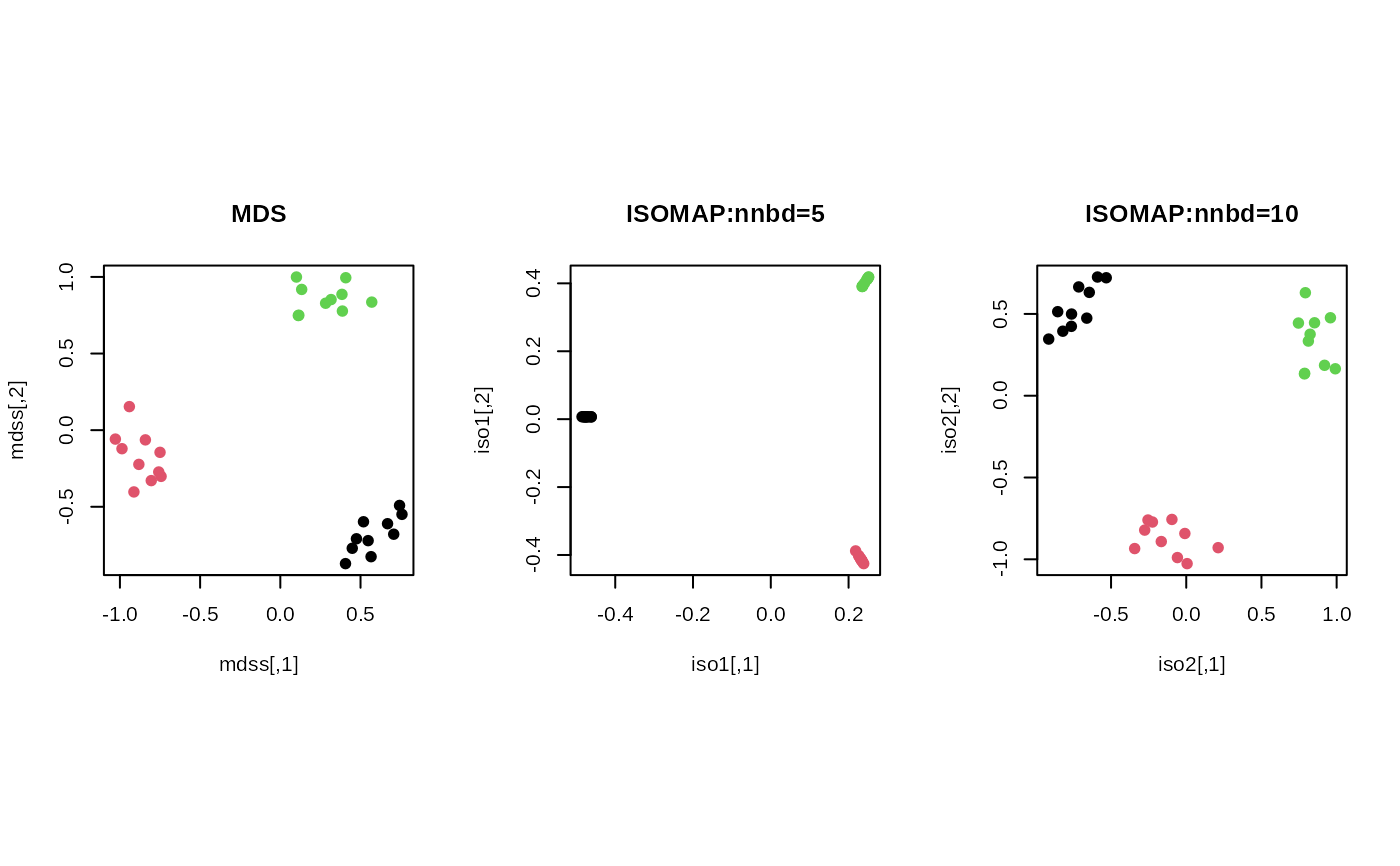ISOMAP - isometric feature mapping - is a dimensionality reduction method
to apply classical multidimensional scaling to the geodesic distance
that is computed on a weighted nearest neighborhood graph. Nearest neighbor
is defined by \(k\)-NN where two observations are said to be connected when
they are mutually included in each other's nearest neighbor. Note that
it is possible for geodesic distances to be Inf when nearest neighbor
graph construction incurs separate connected components. When an extra
parameter padding=TRUE, infinite distances are replaced by 2 times
the maximal finite geodesic distance.
Usage
riem.isomap(
riemobj,
ndim = 2,
nnbd = 5,
geometry = c("intrinsic", "extrinsic"),
...
)Arguments
- riemobj
a S3
"riemdata"class for \(N\) manifold-valued data.- ndim
an integer-valued target dimension (default: 2).
- nnbd
the size of nearest neighborhood (default: 5).
- geometry
(case-insensitive) name of geometry; either geodesic (
"intrinsic") or embedded ("extrinsic") geometry.- ...
extra parameters including
- padding
a logical; if
TRUE,Inf-valued geodesic distances are replaced by 2 times the maximal geodesic distance in the data.
Value
a named list containing
- embed
an \((N\times ndim)\) matrix whose rows are embedded observations.
References
Silva VD, Tenenbaum JB (2003). “Global Versus Local Methods in Nonlinear Dimensionality Reduction.” In Becker S, Thrun S, Obermayer K (eds.), Advances in Neural Information Processing Systems 15, 721–728. MIT Press.
Examples
#-------------------------------------------------------------------
# Example on Sphere : a dataset with three types
#
# 10 perturbed data points near (1,0,0) on S^2 in R^3
# 10 perturbed data points near (0,1,0) on S^2 in R^3
# 10 perturbed data points near (0,0,1) on S^2 in R^3
#-------------------------------------------------------------------
## GENERATE DATA
mydata = list()
for (i in 1:10){
tgt = c(1, stats::rnorm(2, sd=0.1))
mydata[[i]] = tgt/sqrt(sum(tgt^2))
}
for (i in 11:20){
tgt = c(rnorm(1,sd=0.1),1,rnorm(1,sd=0.1))
mydata[[i]] = tgt/sqrt(sum(tgt^2))
}
for (i in 21:30){
tgt = c(stats::rnorm(2, sd=0.1), 1)
mydata[[i]] = tgt/sqrt(sum(tgt^2))
}
myriem = wrap.sphere(mydata)
mylabs = rep(c(1,2,3), each=10)
## MDS AND ISOMAP WITH DIFFERENT NEIGHBORHOOD SIZE
mdss = riem.mds(myriem)$embed
iso1 = riem.isomap(myriem, nnbd=5)$embed
#> [1] "* riem.isomap : some of the geodesic distances are Inf, so 'padding' is applied."
iso2 = riem.isomap(myriem, nnbd=10)$embed
## VISUALIZE
opar = par(no.readonly=TRUE)
par(mfrow=c(1,3), pty="s")
plot(mdss, col=mylabs, pch=19, main="MDS")
plot(iso1, col=mylabs, pch=19, main="ISOMAP:nnbd=5")
plot(iso2, col=mylabs, pch=19, main="ISOMAP:nnbd=10")
 par(opar)
par(opar)
